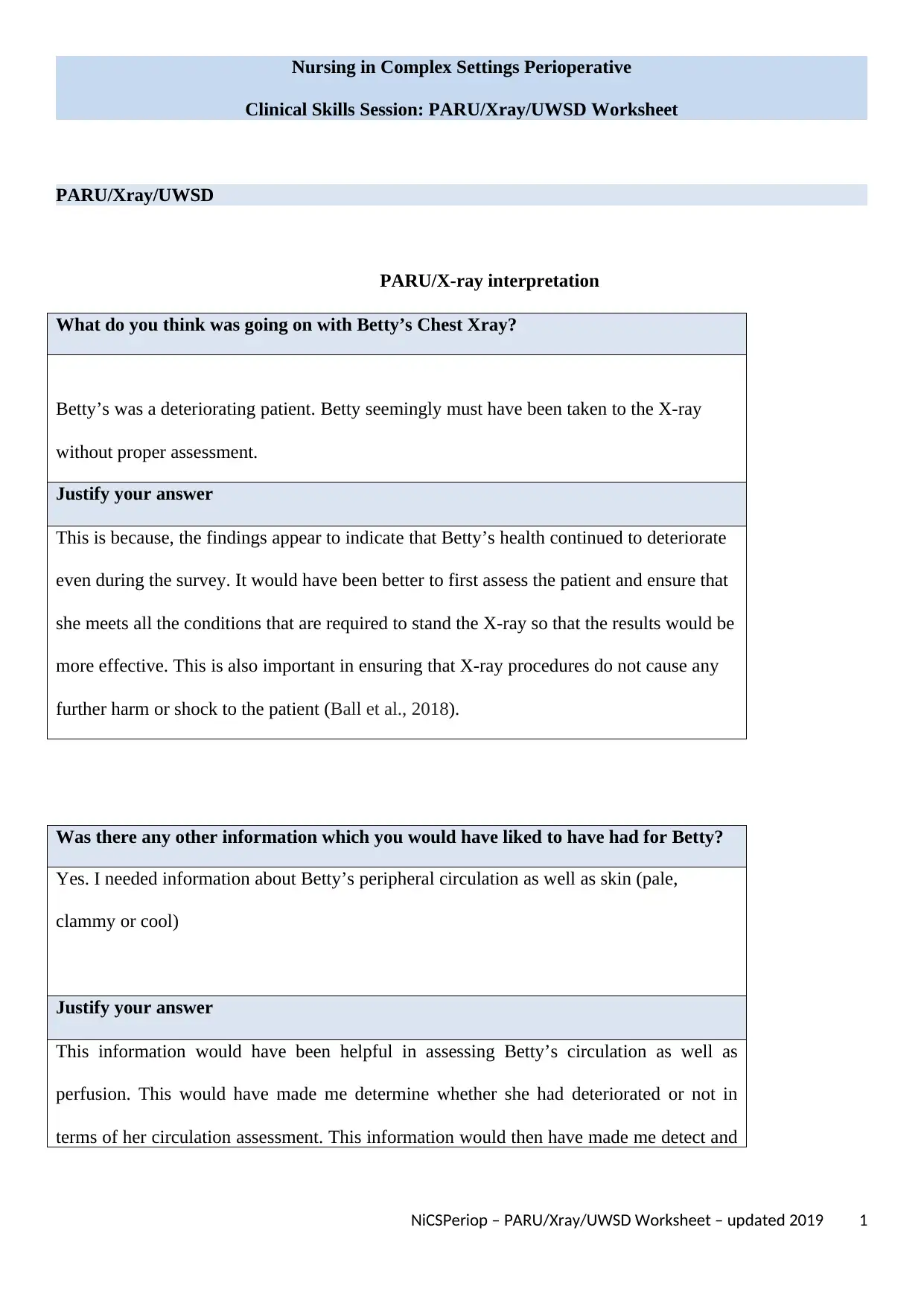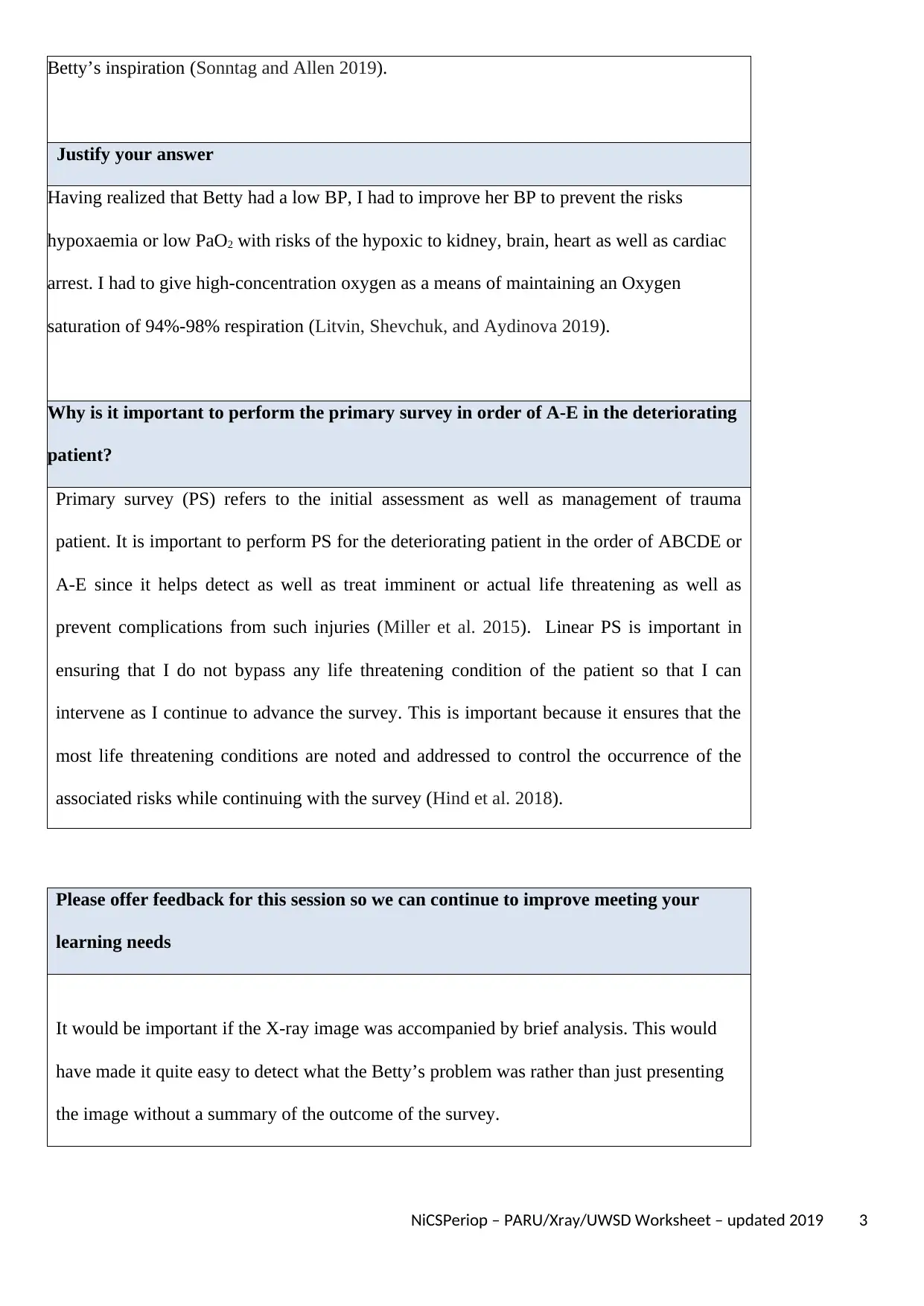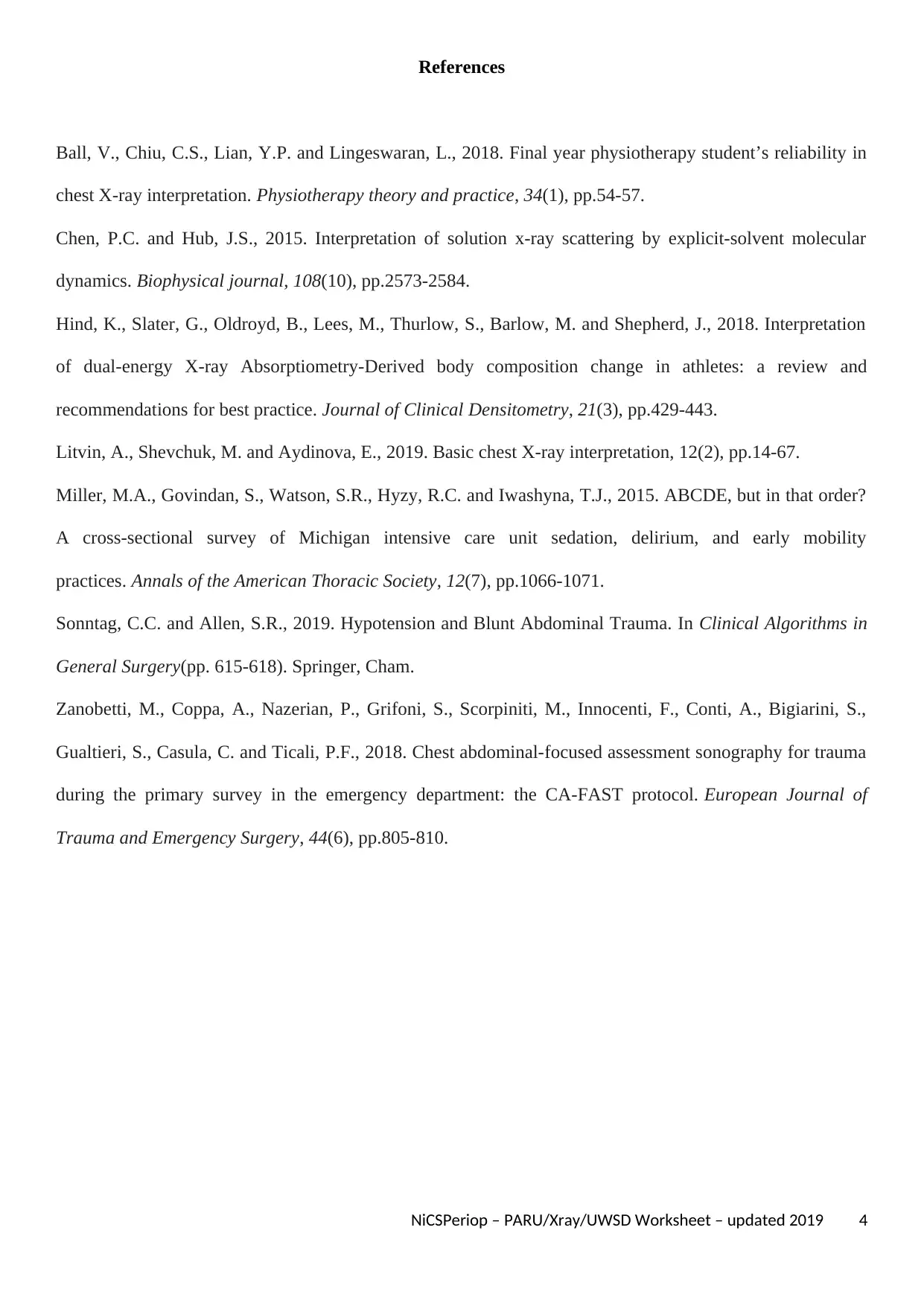Clinical Skills Session: PARU/Xray/UWSD Worksheet
VerifiedAdded on 2022/12/30
|4
|1259
|59
AI Summary
This worksheet includes discussions on PARU/X-ray interpretation, the importance of performing the primary survey in a deteriorating patient, and feedback for improvement. It also provides references for further reading.
Contribute Materials
Your contribution can guide someone’s learning journey. Share your
documents today.

Nursing in Complex Settings Perioperative
Clinical Skills Session: PARU/Xray/UWSD Worksheet
PARU/Xray/UWSD
PARU/X-ray interpretation
What do you think was going on with Betty’s Chest Xray?
Betty’s was a deteriorating patient. Betty seemingly must have been taken to the X-ray
without proper assessment.
Justify your answer
This is because, the findings appear to indicate that Betty’s health continued to deteriorate
even during the survey. It would have been better to first assess the patient and ensure that
she meets all the conditions that are required to stand the X-ray so that the results would be
more effective. This is also important in ensuring that X-ray procedures do not cause any
further harm or shock to the patient (Ball et al., 2018).
Was there any other information which you would have liked to have had for Betty?
Yes. I needed information about Betty’s peripheral circulation as well as skin (pale,
clammy or cool)
Justify your answer
This information would have been helpful in assessing Betty’s circulation as well as
perfusion. This would have made me determine whether she had deteriorated or not in
terms of her circulation assessment. This information would then have made me detect and
NiCSPeriop – PARU/Xray/UWSD Worksheet – updated 2019 1
Clinical Skills Session: PARU/Xray/UWSD Worksheet
PARU/Xray/UWSD
PARU/X-ray interpretation
What do you think was going on with Betty’s Chest Xray?
Betty’s was a deteriorating patient. Betty seemingly must have been taken to the X-ray
without proper assessment.
Justify your answer
This is because, the findings appear to indicate that Betty’s health continued to deteriorate
even during the survey. It would have been better to first assess the patient and ensure that
she meets all the conditions that are required to stand the X-ray so that the results would be
more effective. This is also important in ensuring that X-ray procedures do not cause any
further harm or shock to the patient (Ball et al., 2018).
Was there any other information which you would have liked to have had for Betty?
Yes. I needed information about Betty’s peripheral circulation as well as skin (pale,
clammy or cool)
Justify your answer
This information would have been helpful in assessing Betty’s circulation as well as
perfusion. This would have made me determine whether she had deteriorated or not in
terms of her circulation assessment. This information would then have made me detect and
NiCSPeriop – PARU/Xray/UWSD Worksheet – updated 2019 1
Secure Best Marks with AI Grader
Need help grading? Try our AI Grader for instant feedback on your assignments.

manage Betty’s shock or reduced tissue perfusion (Chen and Hub 2015).
Primary survey
Select 1 (one) phase of the Primary survey (A-E)
Describe your part, an abnormal observation/assessment element you found, and what
intervention you did to help address the problem.
Description (Airway/A): Airway obstructions remains an emergency which calls for
immediate attention since it might cause hypoxia and even risks damage to kidney, brain,
heart, and even cardiac arrest. Therefore, my part involved performing assessment to the
airway patency as well as stability during the Betty’s PS in order that I plan for management
of her airway. Therefore, I looked for the signs of airway obstructions like paradoxical chest
as well as abdominal movement and Betty’s use of accessory muscles of respiration. I
realized that the entry air entry is diminished and noisy.
Observation: The abnormal observation made in Betty’s case is the extremely low blood
pressure of 90/50. The diastolic has gone below 60 which indicates an extremely low BP
which can be life threatening if not reversed to normalcy. This is the reason her saturation is
also low at 90% when it should be between 94%-98%. This is also demonstrated by the low
oxygen flow of which is 10L when it should be 15L (Zanobetti, et al. 2018).
Intervention: I intervened to prevent the occurrence of hypoxaemia or low PaO2 with risks
of the hypoxic to kidney, brain, heart as well as cardiac arrest. First, I used simple methods
to clear airway like airway opening manoeuvres, and airway suctions. I also administered
high-concentration Oxygen with self-inflating bah because she had undergone extubation. I
ensured that Oxygen flow stood sufficient at 15L min -1 to deter collapse of reservoir during
NiCSPeriop – PARU/Xray/UWSD Worksheet – updated 2019 2
Primary survey
Select 1 (one) phase of the Primary survey (A-E)
Describe your part, an abnormal observation/assessment element you found, and what
intervention you did to help address the problem.
Description (Airway/A): Airway obstructions remains an emergency which calls for
immediate attention since it might cause hypoxia and even risks damage to kidney, brain,
heart, and even cardiac arrest. Therefore, my part involved performing assessment to the
airway patency as well as stability during the Betty’s PS in order that I plan for management
of her airway. Therefore, I looked for the signs of airway obstructions like paradoxical chest
as well as abdominal movement and Betty’s use of accessory muscles of respiration. I
realized that the entry air entry is diminished and noisy.
Observation: The abnormal observation made in Betty’s case is the extremely low blood
pressure of 90/50. The diastolic has gone below 60 which indicates an extremely low BP
which can be life threatening if not reversed to normalcy. This is the reason her saturation is
also low at 90% when it should be between 94%-98%. This is also demonstrated by the low
oxygen flow of which is 10L when it should be 15L (Zanobetti, et al. 2018).
Intervention: I intervened to prevent the occurrence of hypoxaemia or low PaO2 with risks
of the hypoxic to kidney, brain, heart as well as cardiac arrest. First, I used simple methods
to clear airway like airway opening manoeuvres, and airway suctions. I also administered
high-concentration Oxygen with self-inflating bah because she had undergone extubation. I
ensured that Oxygen flow stood sufficient at 15L min -1 to deter collapse of reservoir during
NiCSPeriop – PARU/Xray/UWSD Worksheet – updated 2019 2

Betty’s inspiration (Sonntag and Allen 2019).
Justify your answer
Having realized that Betty had a low BP, I had to improve her BP to prevent the risks
hypoxaemia or low PaO2 with risks of the hypoxic to kidney, brain, heart as well as cardiac
arrest. I had to give high-concentration oxygen as a means of maintaining an Oxygen
saturation of 94%-98% respiration (Litvin, Shevchuk, and Aydinova 2019).
Why is it important to perform the primary survey in order of A-E in the deteriorating
patient?
Primary survey (PS) refers to the initial assessment as well as management of trauma
patient. It is important to perform PS for the deteriorating patient in the order of ABCDE or
A-E since it helps detect as well as treat imminent or actual life threatening as well as
prevent complications from such injuries (Miller et al. 2015). Linear PS is important in
ensuring that I do not bypass any life threatening condition of the patient so that I can
intervene as I continue to advance the survey. This is important because it ensures that the
most life threatening conditions are noted and addressed to control the occurrence of the
associated risks while continuing with the survey (Hind et al. 2018).
Please offer feedback for this session so we can continue to improve meeting your
learning needs
It would be important if the X-ray image was accompanied by brief analysis. This would
have made it quite easy to detect what the Betty’s problem was rather than just presenting
the image without a summary of the outcome of the survey.
NiCSPeriop – PARU/Xray/UWSD Worksheet – updated 2019 3
Justify your answer
Having realized that Betty had a low BP, I had to improve her BP to prevent the risks
hypoxaemia or low PaO2 with risks of the hypoxic to kidney, brain, heart as well as cardiac
arrest. I had to give high-concentration oxygen as a means of maintaining an Oxygen
saturation of 94%-98% respiration (Litvin, Shevchuk, and Aydinova 2019).
Why is it important to perform the primary survey in order of A-E in the deteriorating
patient?
Primary survey (PS) refers to the initial assessment as well as management of trauma
patient. It is important to perform PS for the deteriorating patient in the order of ABCDE or
A-E since it helps detect as well as treat imminent or actual life threatening as well as
prevent complications from such injuries (Miller et al. 2015). Linear PS is important in
ensuring that I do not bypass any life threatening condition of the patient so that I can
intervene as I continue to advance the survey. This is important because it ensures that the
most life threatening conditions are noted and addressed to control the occurrence of the
associated risks while continuing with the survey (Hind et al. 2018).
Please offer feedback for this session so we can continue to improve meeting your
learning needs
It would be important if the X-ray image was accompanied by brief analysis. This would
have made it quite easy to detect what the Betty’s problem was rather than just presenting
the image without a summary of the outcome of the survey.
NiCSPeriop – PARU/Xray/UWSD Worksheet – updated 2019 3

References
Ball, V., Chiu, C.S., Lian, Y.P. and Lingeswaran, L., 2018. Final year physiotherapy student’s reliability in
chest X-ray interpretation. Physiotherapy theory and practice, 34(1), pp.54-57.
Chen, P.C. and Hub, J.S., 2015. Interpretation of solution x-ray scattering by explicit-solvent molecular
dynamics. Biophysical journal, 108(10), pp.2573-2584.
Hind, K., Slater, G., Oldroyd, B., Lees, M., Thurlow, S., Barlow, M. and Shepherd, J., 2018. Interpretation
of dual-energy X-ray Absorptiometry-Derived body composition change in athletes: a review and
recommendations for best practice. Journal of Clinical Densitometry, 21(3), pp.429-443.
Litvin, A., Shevchuk, M. and Aydinova, E., 2019. Basic chest X-ray interpretation, 12(2), pp.14-67.
Miller, M.A., Govindan, S., Watson, S.R., Hyzy, R.C. and Iwashyna, T.J., 2015. ABCDE, but in that order?
A cross-sectional survey of Michigan intensive care unit sedation, delirium, and early mobility
practices. Annals of the American Thoracic Society, 12(7), pp.1066-1071.
Sonntag, C.C. and Allen, S.R., 2019. Hypotension and Blunt Abdominal Trauma. In Clinical Algorithms in
General Surgery(pp. 615-618). Springer, Cham.
Zanobetti, M., Coppa, A., Nazerian, P., Grifoni, S., Scorpiniti, M., Innocenti, F., Conti, A., Bigiarini, S.,
Gualtieri, S., Casula, C. and Ticali, P.F., 2018. Chest abdominal-focused assessment sonography for trauma
during the primary survey in the emergency department: the CA-FAST protocol. European Journal of
Trauma and Emergency Surgery, 44(6), pp.805-810.
NiCSPeriop – PARU/Xray/UWSD Worksheet – updated 2019 4
Ball, V., Chiu, C.S., Lian, Y.P. and Lingeswaran, L., 2018. Final year physiotherapy student’s reliability in
chest X-ray interpretation. Physiotherapy theory and practice, 34(1), pp.54-57.
Chen, P.C. and Hub, J.S., 2015. Interpretation of solution x-ray scattering by explicit-solvent molecular
dynamics. Biophysical journal, 108(10), pp.2573-2584.
Hind, K., Slater, G., Oldroyd, B., Lees, M., Thurlow, S., Barlow, M. and Shepherd, J., 2018. Interpretation
of dual-energy X-ray Absorptiometry-Derived body composition change in athletes: a review and
recommendations for best practice. Journal of Clinical Densitometry, 21(3), pp.429-443.
Litvin, A., Shevchuk, M. and Aydinova, E., 2019. Basic chest X-ray interpretation, 12(2), pp.14-67.
Miller, M.A., Govindan, S., Watson, S.R., Hyzy, R.C. and Iwashyna, T.J., 2015. ABCDE, but in that order?
A cross-sectional survey of Michigan intensive care unit sedation, delirium, and early mobility
practices. Annals of the American Thoracic Society, 12(7), pp.1066-1071.
Sonntag, C.C. and Allen, S.R., 2019. Hypotension and Blunt Abdominal Trauma. In Clinical Algorithms in
General Surgery(pp. 615-618). Springer, Cham.
Zanobetti, M., Coppa, A., Nazerian, P., Grifoni, S., Scorpiniti, M., Innocenti, F., Conti, A., Bigiarini, S.,
Gualtieri, S., Casula, C. and Ticali, P.F., 2018. Chest abdominal-focused assessment sonography for trauma
during the primary survey in the emergency department: the CA-FAST protocol. European Journal of
Trauma and Emergency Surgery, 44(6), pp.805-810.
NiCSPeriop – PARU/Xray/UWSD Worksheet – updated 2019 4
1 out of 4
Your All-in-One AI-Powered Toolkit for Academic Success.
+13062052269
info@desklib.com
Available 24*7 on WhatsApp / Email
![[object Object]](/_next/static/media/star-bottom.7253800d.svg)
Unlock your academic potential
© 2024 | Zucol Services PVT LTD | All rights reserved.


